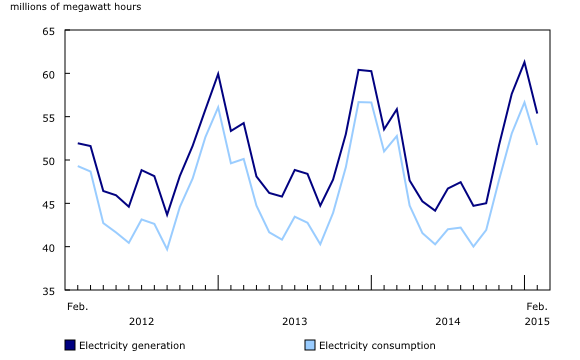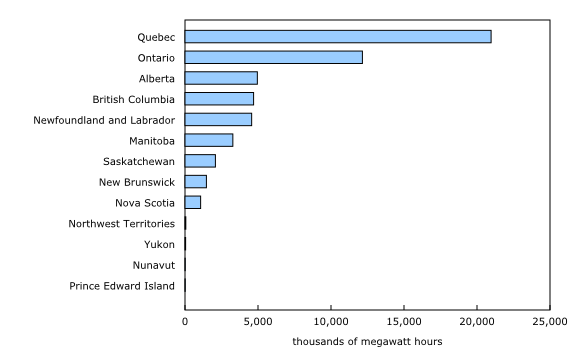Electric power statistics, February 2015
Archived Content
Information identified as archived is provided for reference, research or recordkeeping purposes. It is not subject to the Government of Canada Web Standards and has not been altered or updated since it was archived. Please "contact us" to request a format other than those available.
Released: 2015-04-24
Electric power generation in Canada totalled 55.4 million megawatt hours (MWh) in February, 3.4% higher than February 2014 levels. The increase was driven by higher generation levels in Quebec, Ontario, Manitoba and Newfoundland and Labrador. Exports to the United States rose 29.9% to 5.0 million MWh on higher deliveries from Ontario and British Columbia, while imports increased 5.2% to 1.3 million MWh. With generation levels increasing more than the gain in net exports, Canada's supply of electricity rose 1.5% to 51.7 million MWh.
Quebec's electric power generation rose 6.6% to 21.0 million MWh; the highest level on record for the month of February, as average temperatures across the province fell more than seven degrees below historical norms. With electricity being the main source of heating in the province, demand also peaked at 23.0 million MWh, up 11.2% from February 2014 levels. Further evidence of the increased demand was the 20.9% year-over-year increase in receipts from other provinces and the United States, as well as an 8.4% decline in electricity flowing out of the province.
Colder temperatures also contributed to increased demand across Newfoundland and Labrador, Manitoba and New Brunswick, where residents rely strongly on electricity as the primary heating source. In Manitoba, demand rose 19.9% year over year to 3.0 million MWh, while demand in Newfoundland and Labrador topped 1.3 million MWh (+40.8%) and New Brunswick reached 1.5 million MWh (+11.1%). Generation levels rose across the three provinces to meet the higher demand, while New Brunswick also cut back on exports to the United States.
In British Columbia, the picture was reversed as both generation and demand fell significantly in the wake of warmer temperatures. Electric power generation dropped a fifth of its volume from February 2014 on lower hydro production to 4.7 million MWh. Lower generation levels, combined with a small increase in the province's net inflows of electricity, left the supply of electricity in the province at 4.8 million MWh, 18.6% lower than the same month a year earlier.
Note to readers
The purpose of this report is to produce a consistent monthly indicator of the supply of electricity in Canada, a key input in the calculation of monthly gross domestic product.
Total net electricity generation for Canada, the provinces and the territories combines all of the electricity generated from all sources, including hydro, steam, nuclear, internal combustion, wind, solar, tidal and other.
Total available electricity is the total electricity generation, minus deliveries, plus receipts of electricity.
All data on imports and exports are provided directly by the National Energy Board.
Data for January and December 2014, as well as for January 2015 have been revised.
Contact information
For more information, or to enquire about the concepts, methods or data quality of this release, contact us (toll-free 1-800-263-1136; 514-283-8300; infostats@statcan.gc.ca) or Media Relations (613-951-4636; statcan.mediahotline-ligneinfomedias.statcan@canada.ca).
- Date modified:



